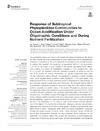Identificador persistente para citar o vincular este elemento:
https://accedacris.ulpgc.es/handle/10553/51624
| Título: | Response of subtropical phytoplankton communities to ocean acidification under oligotrophic conditions and during nutrient fertilization | Autores/as: | Taucher, Jan Arístegui, Javier Bach, Lennart T. Guan, Wanchun Montero, María F. Nauendorf, Alice Achterberg, Eric P. Riebesell, Ulf |
Clasificación UNESCO: | 251001 Oceanografía biológica | Palabras clave: | Ocean acidification Phytoplankton Marine ecology Diatoms Oligotrophic oceans, et al. |
Fecha de publicación: | 2018 | Proyectos: | Flujos de Carbono en Un Sistema de Afloramiento Costero (Cabo Blanco, Nw de Africa). Papel Del Carbono Disuelto y en Suspension en El Contexto de la Bomba Biologica. | Publicación seriada: | Frontiers in Marine Science | Resumen: | The subtropical oceans are home to the largest phytoplankton biome on the planet. Yet, little is known about potential impacts of ocean acidification (OA) on phytoplankton community composition in the vast oligotrophic ecosystems of the subtropical gyres. To address this question, we conducted an experiment with 9 in situ mesocosms (~35 m3) off the coast of Gran Canaria in the eastern subtropical North Atlantic over a period of 9 weeks. By establishing a gradient of pCO2 ranging from ~350 to 1,025 μatm, we simulated carbonate chemistry conditions as projected until the end of the twenty-first century. Furthermore, we injected nutrient-rich deep water into the mesocosms halfway through the experiment to simulate a natural upwelling event, which regularly leads to patchy nutrient fertilization in the study region. The temporal developments of major taxonomic groups of phytoplankton were analyzed by flow cytometry, pigment composition and microscopy. We observed distinct shifts in phytoplankton community structure in response to high CO2, with markedly different patterns depending on nutrient status of the system. Phytoplankton biomass during the oligotrophic phase was dominated by picocyanobacteria (Synechococcus), which constituted 60–80% of biomass and displayed significantly higher cell abundances at elevated pCO2. The addition of deep water triggered a substantial bloom of large, chain-forming diatoms (mainly Guinardia striata and Leptocylindrus danicus) that dominated the phytoplankton community during the bloom phase (70–80% of biomass) and until the end of the experiment. A CO2 effect on bulk diatom biomass became apparent only in the highest CO2 treatments (>800 μatm), displaying elevated concentrations especially in the stationary phase after nutrient depletion. Notably, these responses were tightly linked to distinct interspecific shifts within the diatom assemblage, particularly favoring the largest species Guinardia striata. Other taxonomic groups contributed less to total phytoplankton biomass, but also displayed distinct responses to OA treatments. For instance, higher CO2 favored the occurrence of prymnesiophyceae (Phaeocystis globosa) and dictyochophyceae, whereas dinoflagellates were negatively affected by increasing CO2. Altogether, our findings revealed considerable shifts in species composition in response to elevated CO2 and/or lower pH, indicating that phytoplankton communities in the subtropical oligotrophic oceans might be profoundly altered by ocean acidification. | URI: | https://accedacris.ulpgc.es/handle/10553/51624 | ISSN: | 2296-7745 | DOI: | 10.3389/fmars.2018.00330 | Fuente: | Frontiers in Marine Science [ISSN 2296-7745], v. 5 (330) |
| Colección: | Artículos |
Citas SCOPUSTM
22
actualizado el 08-jun-2025
Citas de WEB OF SCIENCETM
Citations
21
actualizado el 08-jun-2025
Visitas
181
actualizado el 15-mar-2025
Descargas
136
actualizado el 15-mar-2025
Google ScholarTM
Verifica
Altmetric
Comparte
Exporta metadatos
Los elementos en ULPGC accedaCRIS están protegidos por derechos de autor con todos los derechos reservados, a menos que se indique lo contrario.
